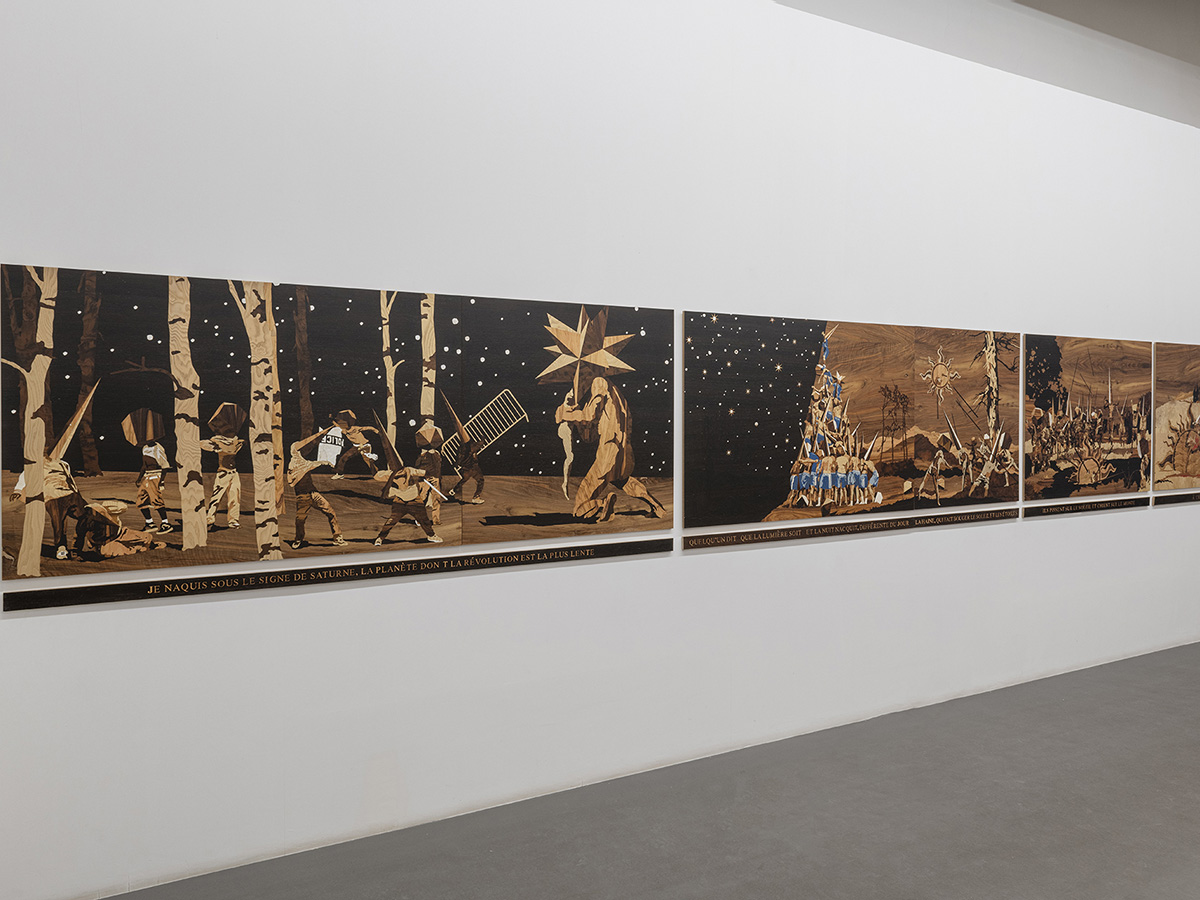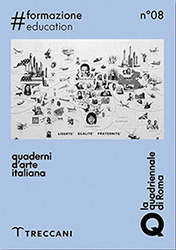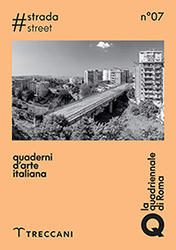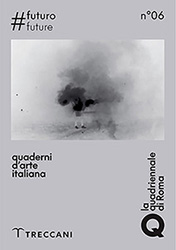Collective Trauma as a Paradigm of Meaning in Contemporary Western Artistic Research
Chiara Gargiuli
In 1980, the American Psychiatric Association included for the first time, in the third edition of its manual, the symptoms of a new illness: post-traumatic stress disorder. Known as PTSD, this mental-health condition can develop in some individuals after they have experienced or witnessed a traumatic situation.[1]
When experiencing a potentially traumatic event, the sympathetic nervous system sends a series of stimuli to the body that allows it to respond with a fight-or-flight reaction.[2] If the response is successful, and we manage to move away from the threat, our body will regain its balance and we can find our way to get over whatever has happened. But if such a response is blocked and we are unable to physically move away from the problem, the brain will continue to send the same stimuli in vain — not only hours after the event is over, but every time this situation seems to recur.[3]
Postmodern society is marked by a strong scepticism towards grand narratives,[4] and its greater attention towards individual experiences. The destigmatisation of therapy and rising awareness about mental health have led to a greater familiarity not only with the concept of trauma, but also to its extension beyond the particular context of war, within which it was originally theorised. Trauma can result from physical, sexual or psychological abuse, discrimination, or prejudice; depending on the conditions in which it is generated, we can distinguish among different types, such as cultural trauma, racial trauma, or institutional trauma. When it is a wound shared among multiple individuals, it is called collective trauma.[5] Unlike individual trauma, which affects a person according to their own lived experience, collective trauma implies a shared experience that profoundly impacts a wider community, affecting the identity of its members, its social cohesion or fragmentation, and this same group’s cultural expression.[6]
There are many factors feeding into a contemporary collective trauma, encapsulated in the fragmentation of the postmodern self. These factors include our constant exposure to global events; information overload; the impossibility of escaping awareness of environmental disaster or social injustice;[7] our active participation in rapid and closely interwoven technological innovations;[8] and the difficulty of keeping up with new narrative models. Faced with the dystopian narratives that constitute our reality, identity itself suffers constant traumas, which it is not only unable to react to effectively[9] but — more importantly — it can never escape. The grotesque and absurd ‘wrong timeline’[10] which we have entered into serves to blur the boundary between material and immaterial, between real and virtual,[11] and this in turn challenges the concept of the linearity of time.
All this seems to translate into artistic languages that collect, investigate, and make archives. Contemporary artists, with particular reference to Western culture, work by creating a narrative that tries to make sense of what has been — as if we had reached the end of time.[12] On the other hand, if in the contemporary era, linear time is declining in favour of an eternal present in which past and future collapse into a continuous flow of fragmented experiences[13] (and this is exactly the same condition of temporal annihilation caused by traumatic events, where a trigger is enough to generate the same physical reaction even years later), it is unsurprising that artists feel the need to turn to traditional languages. While this process allows a rewriting of narratives, by drawing on historical precedents and artistic legacies, it also speaks to a subliminal search for stability, faced with the frenetic postmodern delirium.[14]
In order to explore these issues further, it may be especially illustrative to analyse a 2018 work by Andrea Mastrovito, entitled Le jardin des histoires du monde, and recently exhibited at Palazzo Braschi for the Quadriennale di Roma’s Quotidiana exhibition programme.[15] The work, realised in wooden inlay, is a long frieze that recounts the crisis-elements of Western culture in tragic tones. The choice of tragedy — a theme highlighted by the exhibition’s curator Nicolas Martino in his critical text[16] ─ is particularly significant: for Arthur Miller, moreover, ‘the tragic right is a condition of life in which the human personality is able to flower and realize itself’.[17] That is, it is able to create something that represents its identity — all the more so when we find this identity impossible to define.[18] Mastrovito uses a narrative-type visual language as a means of processing the trauma of living at the end of time, elevating human experience to a mythical tale, and juxtaposing contemporary scenes — such as the images of the urban revolt in Baltimore — with legendary iconographies. Sublimation, a process of refinement and transformation, becomes the focus of his narrative: Lucrezia Longobardi speaks of a reverse catharsis.[19] Through this lens, Mastrovito explores the depths of human experience, crafting a tragedy based not on raw reality, but on an Apollonian and conceptual aesthetic reworking. Longobardi proposes a comparison with the work of Thomas Hirschhorn and Teresa Margolles. Unlike them, the aesthetics of Mastrovito’s work — which is apparently serene and orderly — is only the beginning of a journey that leads us towards the crude reality of the postmodern human condition, which must come to terms with a lived experience conjugated in the eternal present. The catharsis proposed by the artist does not elevate, does not look beyond, but rather brings us back down to Earth — reminding us of our wounded, fragmented, imperfect and worldly essence.
A different approach can be found in the research of Kara Walker, an artist who recontextualises historical narratives by calling for a critical examination of the systems in which power and violence have shaped the American experience. In the absence of unambiguous tools to communicate a present that is overwhelming and fragmented, mythic narrative seems to become the linguistic resource par excellence for exploring collective trauma. An example of such trauma is the various forms of racial abuse. We see this in the installation Slavery! Slavery! Presenting a GRAND and LIFELIKE Panoramic Journey into Picturesque Southern Slavery[20] (1997), in which the artist assembles grotesque and enormous black silhouettes drawn on paper on a white background, in a detailed and disturbing representation of life on the plantations of the American South.[21] The artist recounts the collective trauma of slavery, presenting a critical exploration of institutions, delving into the complexities of power dynamics, racial identity and dehumanisation. Here, we see how the public reaffirmation of the pain of a collective wound is a way of regaining control and asserting one’s own narrative. This is an entirely conscious operation.[22] As in the case of Les jardins des histoires du monde, it identifies the mythical tale as a source of healing, as well as the possibility of new and healing narratives. Still, we would do well to stress that Walker’s poetics are quite different from Mastrovito’s, to which they have an almost mirror-image relationship. Indeed, the American artist delves deep into the brutal and chaotic reality of slavery, presenting emotionally intense and often disturbing scenes. The violence is explicit and denounced from the outset, rather than being concealed behind a compositional order. The installation aesthetically aligns with the Dionysian impulse to confront the chaotic, painful and traumatic aspects of the human experience, provoking a visceral and cathartic reaction through the representation of abuse.
Rather like Walker, artist Chiara Fumai often proposes a social critique from a feminist perspective, with a view to possible redemption from dominant narratives. “Comrades”, “sisters”, “allies”: healing from collective trauma is a common endeavour. This is how the artist evokes the various figures interpreted by her[23] in performances such as The Book Of Evil Spirits (2015), a representation of a séance during which Fumai’s body becomes a medium for various historical female figures, including Eusapia Palladino, Annie Jones, Zalumma Agra and Ulrike Meinhof. This mediumistic practice allows the artist to transcend all temporal limits,[24] setting the past within the present and giving these women the possibility of telling their own stories.[25] Such an operation itself lays claim to the pulsional and hysterical language[26] of esotericism, a prejudice of a patriarchal society that grants the feminine gender only roles that pertain to the sphere of irrationality.[27] The interpretation of the role of mediumbecomes a metanarrative act: the artist herself, in the moment of her performance, makes her body a multidirectional channel of catharsis and healing. This allows the working-through of the past and affords the possibility of alternatives.
Kader Attia’s works also confront the dimension of trauma through a mythical narrative, exploring historical and cultural aspects that have left lasting scars on individuals and communities. In The Repair from Occident to Extra-Occidental Cultures (2012), the French artist explores the concept of repair as a way of healing the collective trauma of postcolonial identity. Here, the act of repairing becomes a symbolic undertaking, which represents the recovery of autonomy and cultural identity, and moreover proposes a reflection on the historical context of each object.[28] Attia has collected damaged objects from various parts of the world, and tries to repair them according to different methods, some of which are traditional and some of which are entirely improvised. By incorporating objects from various cultures and using different methods to repair them, the artist emphasises the multiplicity of possible narratives. They together form an archive of different stories that each bear the wound of colonialism. If, from an aesthetic point of view — as already seen in Mastrovito’s work — the collection of past narratives makes it possible to distinguish them from the fragmented and chaotic postmodern experience of the present, Attia’s operation has further thematic affinities with Fumai’s work. Both artists, in their respective practices, actively intervene on the still-open wounds of a traumatic past, seeking to heal them through a performative-curative act. Fumai’s mediumistic practice and Attia’s work of repair restore a voice to the gueles cassées[29] silenced by the institutions.
This and other unseen but pervasive rifts that divide societies and perpetuate injustice are often invisibilised.[30] In the monumental installation Shibboleth[31] (2007), the Colombian artist Doris Salcedo attempts to make them visible by creating a long crack in the floor of the Turbine Hall of London’s Tate Modern, symbolising the deep divisions of cultural and racial groups, with particular reference to marginalised communities. The work renders a visceral physical image of a traumatic wound that is part of our everyday experience, but which we cannot touch. By confronting viewers with a manifestation of these divisions, Salcedo urges us to reflect on the role of power and privilege in perpetuating collective trauma.
If, as we have seen, Kara Walker’s works are characterised by detailed narrative silhouettes (often making explicit historical references), Salcedo instead conveys her message through minimalism and abstraction. But notwithstanding their use of different mediums, the two artists do bear one important similarity. What dominates their production is not the desire to catalogue and archive the past in order to make sense of the present (as found in Attia and Mastrovito’s works), or that of creating a performative-curative act that redeems the past (as in Attia’s repair and Fumai’s performance), but the healing process that takes place at the moment of experiencing their works. These latter become a moment of collective catharsis in the confrontation with a painful truth, represented in its truest rawness. Walker’s intricate scenes compel the viewer to confront uncomfortable truths about history and identity, while Salcedo’s Shibboleth forces viewers to physically navigate the space around the crack, making them aware of the metaphorical divisions that it represents. Hence both artists make the — invisible — wounds that determine our experience into something tangible, cumbersome, and uncomfortable.
Artistic expression can, however, resonate with an understanding of trauma as not only a source of suffering, but also as a catalyst for growth. In Anastasis (2018), Giorgio Andreotta Calò refers to a resurrection.[32] Through the use of red light, the artist brings the Roman Catholic visual idiom back to the Oude Kerk in Amsterdam, recalling the iconoclastic fury of 1566. In so doing, he appropriates a stable narrative and constructs a tangible experience. This dovetailing with the past evokes a sense of continuity even when faced with historic upheavals in the social fabric.[33] The inverted ship’s hull that forms the central structure of Anastasis can be interpreted as a reversal of conventional expectations, which in turn invites viewers to reconsider their understanding of trauma, and to engage in reflection and contemplation. Like Walker and Salcedo, Calò intervenes in the cathartic moment of the experience of the work. But he overcomes its tension and, in a physical and metaphorical reversal, offers the possibility of healing through the engagement with the work itself.
The chosen artists belong to different generational, cultural and geographical contexts, and this results in aesthetic and thematic choices that are sometimes distant from each other. However, as we have seen, there are also numerous points of contact between them, which help to offer new keys for interpreting the fragmentary nature of our present. The need to adopt tragedy as a narrative model, to investigate the contemporary with the tools of the past, and to elevate the present to a mythical tale, testify to a two-sided tendency that can be seen in the case-studies examined. On the one hand, there is the tendency to seek safe harbour in already established and coherent paradigms (because the stories that we tell ourselves instead appear as incoherent and grotesque — again, we are dealing with a ‘wrong timeline’). On the other hand, there is the tendency to create a cathartic emotional detachment from what we experience, which allows us to relate to the works with a critical sense and to heal from the collective trauma of the eternal present.
[1] While the symptoms had already become clearly apparent following the two World Wars (and they are still today termed ‘shell shock’), the decisive event for understanding this phenomenon was the return of American soldiers from the Vietnam War. See M. Horowitz, Stress Response Syndromes: Character Style and Dynamic Psychotherapy, in “Archives of General Psychiatry”, 31.6, 1974, pp. 768-781; T. Millon, The DSM-III: An Insider’s Perspective, in “American Psychologist”, 38.7, 1983.
[2] This is a crucial integrated survival mechanism: it prepares the body to face the threat (fight) or to flee from it (flight). W.B. Cannon, Bodily Changes in Pain, Hunger, Fear, and Rage, Appleton-Century-Crofts, New York 1929.
[3] This is not, in fact, limited to situations directly akin to the one that has been experienced. The physical (and involuntary) memory of the trauma may make the subject see even innocuous circumstances as dangerous and fearful. A.A. Lima et al., The Impact of Tonic Immobility Reaction on the Prognosis of Posttraumatic Stress Disorder, in “Journal of psychiatric research”, 44.4, 2010, pp. 224-228.
[4] Postmodern scepticism towards grand narratives reflects the rejection of totalising explanations and the recognition of the values of complexity, contingency and plurality as inherent to human experience. It opens up space for alternative voices and perspectives to challenge dominant discourses and power structures, while repudiating absolutisms and established truths. See J.-F. Lyotard, The Postmodern Condition in The Postmodern Turn: New Perspectives on Modern Theory, S. Seidman (ed.), Cambridge University Press 1994; M. Foucault, Power / Knowledge in The New Social Theory Reader, S. Seidman, J. C. Alexander (eds.), Routledge, London 2020, pp. 73-79; J. Derrida, The Deconstruction of Actuality: An Interview with Jacques Derrida in Deconstruction: A Reader, S. Malpas, P. Wake (eds.), Routledge, London 2017; specifically, on postcolonial critiques of Western imperialism and colonialism, see E.W. Said, Culture and Imperialism, Vintage, New York 2012; G.C. Spivak, A Critique of Postcolonial Reason: Toward a History of the Vanishing Present, Harvard University Press, Cambridge, MA, 1999; H.K. Bhabha, The Location of Culture, Routledge, London 2012.
[5] A. Collins, Culture, Narrative and Collective Trauma in “PINS (Psychology in Society)”, 48, 2015, pp. 105-109; B.A. Van der Kolk, Psychological Trauma, APA Publishing, Washington 2003.
[6] R. Eyerman, J.C. Alexander, Cultural Trauma and Collective Identity, University of California Press, Berkeley, CA, 2006.
[7] With regard to ‘ecological grief’, see A. Cunsolo, N.R. Ellis, Ecological Grief as a Mental Health Response to Climate Change-Related Loss, in “Nature Climate Change”, 8.4, 2018, pp. 275-281.
[8] In relation to ‘onlife’, see L. Floridi, The Onlife Manifesto: Being Human in a Hyperconnected Era, Springer Nature 2015. In relation to web society as a sociological model, see A. Alfieri, C. Gargiuli, Perturbante postmoderno: immagini inquietanti nella comunicazione e nell’arte del XXI secolo, Rogas, Rome 2022.
[9] In Italy the last trace of optimism regarding the possibility of action was perhaps extinguished with the events surrounding the G8 summit held in Genoa in 2001. See S. Palidda, Appunti di ricerca sulle violenze delle polizie al G8 di Genova. Studi sulla questione criminale, Carocci Editore, Rome 2008.
[10] M. Salvia, Interregno. Iconografie del XXI secolo, Nero edizioni, Rome 2022.
[11] In relation to the web society, see M. Castells, The Internet Galaxy: Reflections on the Internet, Business, and Society, Oxford University Press, Oxford 2002. On the phenomena that define the postmodern period, see A. Alfieri, C. Gargiuli, Perturbante postmoderno, cit. As for the processes that contribute to the confusion between material and immaterial, see P.M. Leonardi, B.A. Nardi, J. Kallinikos, Materiality and Organising: Social Interaction in a Technological World, Oxford University Press, Oxford 2012.
[12] S. Žižek, Living in the End Times, Verso Books, London 2011.
[13] This process, consistent with the move away from grand narratives (see footnote 4) would seem to be caused by the loss of faith in absolute truths. An aesthetic echo of this can be detected in the shift from history to neo-history, from kitsch to neo-kitsch. In relation to the eternal present, cf. J.-F. Lyotard, The Postmodern Condition, cit. In relation to neo-history and postmodern aesthetic trends, see A. Alfieri, La cultura videomusicale degli anni Ottanta: tra dispersione del soggetto e dissoluzione della storia, in “Society of Individuals”, 46, 2013, pp. 139-152.
[14] The aforementioned lack of established references can translate into a form of cultural criticism or commentary, which questions the way in which historicised events continue to have consequences in contemporary society, and offers new readings of them. For further discussion, see J. Shi, On the 59th Venice Biennale: A Critical Perspective on Hidden Clues, in “International Journal of Education and Humanities” vol. 3, no. 1, 2022, pp. 8-12.
[15] Quotidiana – Landscape, Nicolas Martino – Res gestae. Romeo Castellucci, Andrea Mastrovito, Museo di Roma, Palazzo Braschi, 26 January — 17 March 2024.
[16] N. Martino, Res gestae. Il sentimento tragico della storia nell’arte italiana del XXI secolo, https://quadriennalediroma.org/wp-content/uploads/2024/01/Q_Paesaggio_NicolasMartino.pdf, (last accessed 25 July 2024).
[17] A. Miller, Tragedy and the Common Man, in “Jewish Quarterly”, 62.4, 2015, pp. 62-63.
[18] Writing on Romeo Castellucci, whose Resurrection (2022) transforms Mahler’s Symphony No. 2 into a theatrical performance that emphasises the condemnation of war — an inevitable phenomenon in human experience — Nicolas Martino points out that tragedy becomes a device that allows the “processing of the trauma of the repressed.” N. Martino, Res gestae, cit. Martino, Res gestae, cit.
[19] L. Longobardi, L’opera come un teatro tragico. Tre autori a confronto: Thomas Hirschhorn, Teresa Margolles e Andrea Mastrovito, in: https://quadriennalediroma.org/lopera-come-un-teatro-tragico/
[20] Another title the artist gives to the same work is Life at ‘Ol’ Virginny’s Hole.
[21] Unlike Mastrovito’s formalisation, the simplicity of the mediumused contrasts with the complexity of the narratives conveyed.
[22] “I find that I am rewriting History, trying to make it resemble me, Kara (and me, negress) but doing it in little bits and pieces. It’s a monomaniacal undertaking, but there is a lot of (white, patriarchal) damage to undo”, Kara Walker, interview by A. Subotnick, “Make”, 92 (Special Edition 2002), pp. 25-27, https://www.brooklynmuseum.org/eascfa/about/feminist_art_base/kara-walker, (last accessed 15 July 2024).
[23] M. Farronato, Le Muse inquietanti di Chiara Fumai tra verità e menzogna, https://www.archiviochiarafumai.it/milovan-farronato/
[24] C. Martínez, The Dance of Subsentient and Supersentient Life by Chiara Fumai, https://www.archiviochiarafumai.it/chus-martinez/
[25] F.U. Ragazzi, Chiara Fumai Reads Rosalind Krauss: May the Spectator who Wants to Witness a Miracle Please Step Forward, in F.U. Ragazzi, M. Farronato, A. Bellini, eds., Poems I Will Never Release. Chiara Fumai 2007-2017, NERO Editions, Rome 2021, pp. 48-81. It may be worthwhile to draw a comparison with Hélène Cixous’s reinterpretation of Medusa, which redeems the Gorgon from its traditional associations with fear and male domination, instead transforming it into a symbol of female power and creativity. See H. Cixous, Le rire de la Méduse, “L’Arc”, 61, 1975, pp. 39-54.
[26] A. Bellini, Presenze aliene e scrittura nell’opera di Chiara Fumai, https://www.archiviochiarafumai.it/andrea-bellini/ (last accessed 14 June 2024).
[27] For more on the artist’s positions, see the performance-lecture Secreto provato (apparizione non autorizzata di Airam Bulc), 2016, c. 30’, presented at the 16th Quadriennale d’arte, Altri tempi, altri miti (13 October 2016 — 8 January 2017) in I Would Prefer Not to / Preferirei di no. Esercizi di sottrazione nell’ultima arte italiana, edited by Simone Ciglia and Luigia Lonardelli.
[28] M. Diawara, Kader Attia, une poétique de la réappropriation, in “Littérature”, 2, 2014, pp. 53-62.
[29] Ibid.
[30] It may be worth considering the parallels with the way in which conditions that are not visibly apparent — such as mental disorders and post-traumatic stress disorder — are often subject to stigma and misunderstanding, as societal attitudes can lead to scepticism or rejection of individuals’ experiences ─ thus throwing up obstacles to validation and support. See N.A. Ysasi, A.B. Becton, R.K. Chen, Stigmatizing Effects of Visible Versus Invisible Disabilities, in “Journal of Disability Studies”, 4, 1, 2018, pp. 22-29.
[31] The title comes from a Bible story in which members of a tribe used shibboleth as a codeword to identify outsiders. For further discussion, see S. Baraklianou, Silently Disturbing: The Political Aesthetics of Doris Salcedo’s Recent Installations, “Dialogue Webzine”, March 2008.
[32] The title, which originates from the Greek ἀνίστημι, meaning “to make rise, to raise, to lift up”, seems to be almost in thematic continuity with the installation Senza titolo (La fine del mondo) (2017), created by the artist for the Italian Pavilion at the 57th Venice Biennale.
[33] However, the translation of facts into a tragic tale through a reinterpretation of a specific historical theme is an operation akin to that of using myth as a means of understanding the facts themselves.





